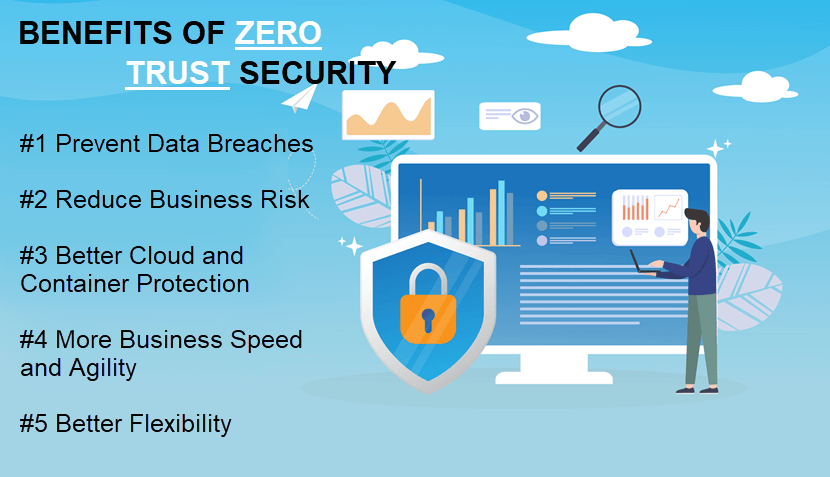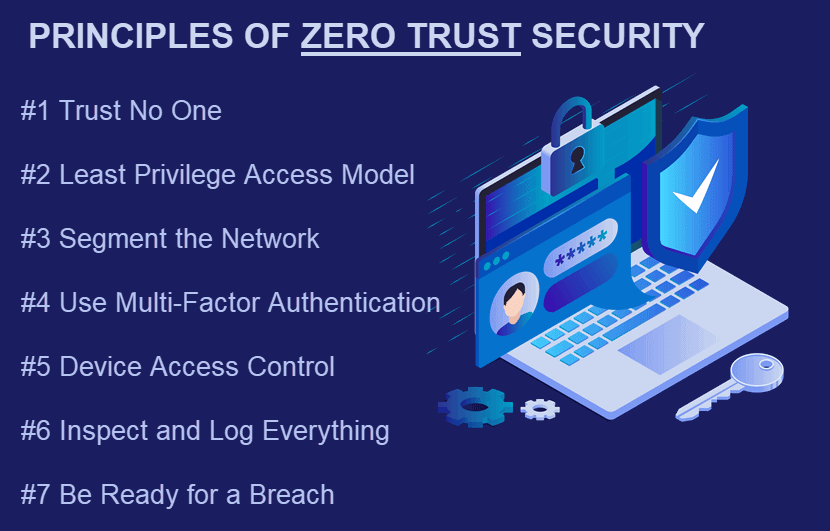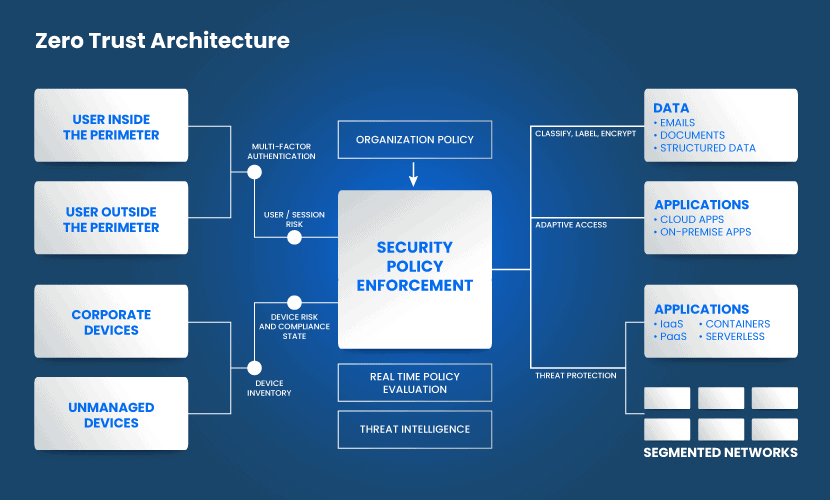This security setup is ideal for protecting a company that relies on cloud computing, remote workforces, and distributed systems. This article will teach you
everything that you need to learn about the Zero Trust Security Model
. We explain how Zero Trust works, what benefits it brings, and why this security strategy is the most effective way of protecting a modern enterprise.What is the Zero Trust Model?Zero Trust is a security strategy in which a company does not automatically trust anything inside or outside the network’s perimeter. Instead, the system verifies every user and device before granting access.
A Zero Trust approach enables a business to:
Thoroughly check every access request.
Protect data, applications, and networks from outside and inside dangers.
- Safely run and thrive in distributed systems.
- Establish an automatic cycle of scanning and responding to threats.
- Easily comply with FISMA, HIPAA, PCI, GDPR, CCPA, and similar data privacy and security laws.
- The goal of Zero Trust is to protect the company from advanced cybersecurity threats and data breaches. A company can stop advanced cybersecurity threats and data breaches by continuously verifying trust across all devices, users, and applications.
Phishing attacks targeting customers and workers. - Lateral movement through the network.
Hackers from using stolen user passwords and application database credentials.
- Database exfiltration via a compromised application host.
- Malicious elevation of application host privileges.
- Unprivileged access to a workstation.
- Zero Trust may include continuous authentication concepts but is not a form of CA. Other terms for Zero Trust are
- Zero Trust Network
- and
Zero Trust Architecture.How the Zero Trust Model WorksZero Trust checks every access request before allowing connection to any asset on the network. Security controls verify access rights based on attributes such as:User identity.
Endpoint hardware types.
Firmware versions.
- Operating system versions.
- Patch levels.
- Weak points and vulnerabilities.
- Installed applications.
- User logins.
- Once security controls permit a user or a device to enter the network, the access is not indefinite. System periodically checks user identities to ensure system protection. Security is kept as close as possible to assets. The result is a protection system that travels with the workload and remains consistent in all environments.
- Zero Trust does not only focus on prevention. Hackers have limited access to data if they breach the perimeter or exploit a bug. The system detects and responds to abnormal behavior before the attacker has enough time to do damage.
- Zero Trust incorporates a range of principles and technologies to protect a system, including:
Automation is a significant aspect of the Zero Trust model. The volume of events that need to be monitored in order to enforce Zero Trust at the enterprise level is too large for humans. Automation keeps security systems running and enforces policies 24/7.
Automate as many remediation, monitoring, and threat detection systems as possible. Such a strategy ensures optimal protection and frees up the team to work on more business-critical tasks.
Traditional Security Architecture vs. Zero Trust Architecture
Traditional network security relies on the
castle-and-moat concept
. Castle-and-moat security focuses on preventing access from outside the network while trusting every user and device already within the perimeter.
This security setup has several flaws that make it ineffective for today’s workloads:
Companies no longer keep data in a single contained area but in large, distributed systems that often include cloud vendors.Trusting users and devices already within the network is no longer safe due to the mobile workforce, BYOD (Bring Your Own Device) policies, IoT, and cloud adoption.Once an attacker gains access to the network, nothing is stopping lateral movement through the system.
Employees and customers access applications from a range of devices and locations.
- The castle-and-moat concept is no longer capable of protecting an enterprise-level network. Zero Trust security, however, offers features ideal for modern corporate systems:
- The network does not trust any user or device by default.
- Verification is necessary for everyone trying to access resources both from inside and outside of the network.
- Every segment in a distributed system has individual security controls that prevent lateral movement.
What Does Zero Trust Security Protect?
- Zero Trust is ideal for protecting modern business environments with a combination of public and private clouds, SaaS applications, and DevOps pipelines. The Zero Trust security model defends:
- Data:
- Zero Trust sets clear rules about where data lives, who can access it, and what is sensitive or stale.
Networks:
Zero Trust networks rely on segmentation, isolation, and strict restrictions to keep attackers out.
- People: Humans are typically the weakest link in any security strategy. Security that is Zero Trust limits, monitors and enforces the way users access resources inside and outside of the network. As a result, threats such as phishing, bad passwords, or malicious insiders are less dangerous.
- Workloads: The Zero Trust model protects the entire stack of applications and back-end software. Strict controls protect everything from data storage, to the operating system and web front-end.
- Devices: Every connected device in a network is a potential entry point for attackers. Zero Trust security model isolates and protects every device in the infrastructure with separate controls.
- Benefits of Zero Trust Security1. Data Breach Prevention
- Data is the most common target of cyberattacks as hackers typically go after:Personally identifiable data (PII).
Protected health information (PHI).

Payment card information (PCI).
Intellectual property (IP).
- Zero Trust is the most effective method of protecting data in an enterprise-level network. Accessing information requires thorough verifying, so every piece of valuable data has a strong layer of protection.
- 2. Less business risk
- The Zero Trust Model is very good at detecting suspicious behaviour. Zero Trust assumes that all users, applications and services are malicious, and they cannot communicate with each other until their identities have been verified. Zero Trust reduces risk by uncovering activity across the network and continuously analyzing how assets are communicating.
- 3. Cloud and Container Protection
The Zero Trust model provides both the visibility and control necessary to keep cloud and container environments safe. If a workload fails the verification, Zero Trust prevents it from communicating anywhere on the system.
Read more about cloud security and learn how to protect your on-cloud operations.
4. More Business Speed and Agility
Traditional security controls often slow down business operations. Blocked ports and shut-down hosts prevent employees from accessing data, cause system errors, and slow processes. Security is not based on a checkpoint but rather follows the workload. Blocks and shutdowns occur in isolation and do not impact other parts of the system.
Zero Trust also provides a clear overview of all users, devices, data, servers, applications, and containers in the infrastructure.
5. Improved Flexibility when Moving Network Assets
Teams frequently move data, applications, and IT Services across the infrastructure. Before the Zero Trust model, moving assets between environments required the team to recreate security policies at the new location manually.
Zero Trust eliminates this time-consuming and error-prone process. The team centrally manages application and data security policies, while automation tools migrate policies on-demand.
Principles of the Zero Trust Security Model
1. Trust No One
The Zero Trust concept is that attackers can be found both inside and outside of the network. The system should never automatically trust users or devices, so every access attempt is a threat until a verification confirms otherwise.
User re-authentication is a vital rule of Zero Trust. Security controls should verify the user’s right to access resources each time they access the system.
2. Use the Least Privilege Access Model
Restrict users to only as much access as they require to perform their duties. Limiting access reduces the risk of each user being exposed to sensitive areas of the network, and also lowers the attack surface. An attacker cannot access large amounts data with a single compromised account.

3. Segment the Network
Network segmentation is the practice of breaking up a network into small zones with separate security controls. A user or program with access to one zone does not have the right to access another area without separate authorization.
Segmentation enables the use of strict access control policies that protect individual workloads. If a breach occurs, network segmentation limits lateral movement and improves system resilience.
4. Multi-Factor Authentication(MFA)
MFA requires users to provide multiple pieces of evidence in order to prove their identity. MFA can be used in a variety of ways. A common example is 2-factor authentication (2FA). The 2FA requires a user to enter both a password as well as a code that is sent from another device. Device Access Control
Zero trust requires strict controls for device access. The system must:
Monitor the number of different devices trying to access the network.
Verify every access attempt.
Strict device access control further reduces the attack surface of the network.
6. Monitor and Log Everything
Continuous inspection of users, devices, and activities is essential to Zero Trust. A company should use an automation tool to monitor every network call, file access, and email for malicious activity.
Monitoring and logging help quickly identify:
Signs of data breaches.
- Dangerous user accounts.
- Patterns in malicious behavior.
System weak points.
Ransomware attacks.
- Real-time monitoring also limits breakout time, the critical window between when attackers access the first machine and when they start moving laterally to other systems.
- 7. Prepare for a breach
- Data leaks are inevitable in Zero Trust environments. Prepare for an attack by:
- Minimizing blast radius.
- Limiting lateral movement in the network.
Preparing a data backup strategy. Setting response tactics. Grow Your Business Without Costly Setbacks
Zero Trust is the most effective method of protecting large networks from advanced cyber threats. Zero Trust is the best way to protect large networks from advanced cyber threats.
